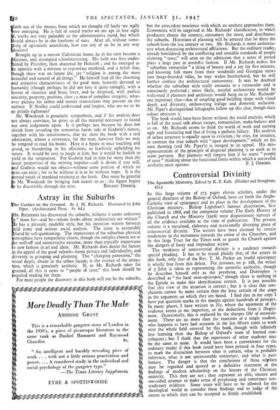O le Castles on the Ground. By J. M. Richards. Illustrated
by John Piper. (Architectural Press. Ss. 6d.) R. RICHARDS has discovered the suburbs, hitherto it seems unknown " those for—and by—whom books about architecture are written."
e has a pleasant, readable style, but his intention wavers between lci irony and serious social analysis. The irony is acceptably • uted by self-questioning. The impressions of the suburban physical tmosphere have sympathetic charm, though the samples chosen are at e well-off and conservative extreme, more than typically impervious o new fashion in art and ideas. Mr. Richards does detect the factors in the appeal of the good suburb—home privacy and individuality, and diversity in grouping and planning. The " changing panorama," the visual depth, absent in the urban facade, is the essence of the attrac- tion, which is genuinely aesthetic. If, as Mr. Richards takes for granted, all this is news to " people of taste," this book should be required reading for them. For most people the discovery in this book will not be the suburbs,
but the antecedent nescience with which an aesthete approaches them. Economists will be surprised at Mr. Richards' classification, in which producers choose the country, consumers the town, and distributors the suburbs. Historians of planning will be amazed that he dates the suburb from the last century or two. Mr. Richards is more authorita- tive when discussing architectural affiliations. But the ordinary reader, already bewildered by the conflicting and unstable standards of people claiming " taste," will seize on the admission -that a sense of period plays a large part in aesthetic fashion. If Mr. Richards makes the " suburban vernacular " a thing of beauty and a joy for five minutes, and knowing folk move from their windmills and Georgian mews into barge-boarded villas, he may widen brotherhood, but he will further confuse the architectural controversy. It may be doubted whether the suburban style really amounts to a vernacular and is consciously preferred ; more likely, tasteful architecture would be welcomed if planners and architects would hang on to Mr. Richards' one important clue—that of coupling good building shape with visual depth and diversity, embowering leafage and domestic seclusion. Mr. Piper's distinguished lithographs follow up this clue, though their colour obscures it.
The book would have been better without the social analysis, which is full of the usual talk about escape, romanticism, make-believe and so on. Mr. Richards seems to think the world of work and earning ugly and frustrating and that of living a pathetic fallacy. His analysis of urban structure is equally open to criticism ; he •tries, for instance, to contrast the true suburb with "open development," which on his own showing (and Mr. Piper's) is integral to its appeal. His mis- representation of the principle of dispersal planning is so stark as to seem perverse. But planners will forgive him if he starts " people of taste " thinking about the functional limits within which a successful


































 Previous page
Previous page